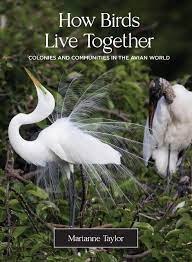How Birds Live together – Colonies and Communities in the Avian World

Marianne Taylor
Princeton University Press, £25.00
People live together in large gatherings in cities, and some birds do too. Whether in our own cities alongside and around us, or in their own massive colonies, perhaps by the sea; roosting overnight in reed beds; or in slightly smaller communities elsewhere. In everyday life it is easy to ignore the lives, complexity of social behaviours or beauty of the avian world. In this book Marianne Taylor provides a lovely and gentle reminder that there is more to bird life if you pay attention and perhaps go looking for it.
Taylor highlights the diversity of ways social birds interact, how and why they do so and the different types of places they live and nest. The book has some lovely photos and some surprises, including a reminder to pay attention to your surroundings when bird watching.
For example, sociable weavers can be found in the Kalahari Desert, Southern Africa. They are relatively small birds that live in large communal structures that at first sight appear to be giant haystacks in a tree, requiring the building efforts of many individuals. The accompanying photograph gives a good idea of scale and it is noted that onlookers should not get too close as many nests contain non-avian lodgers, including wasps that make small nests suspended from the underside of the colony’s nest structure.
This book will be of interest to beginners and keen bird-watchers alike. Although lacking a bibliography, it has a glossary of terms used and explains concepts (such as fission - fusion social groups) within the text with diagrams to add clarity or show supporting data.
Dr Amanda Hardy MRSB


